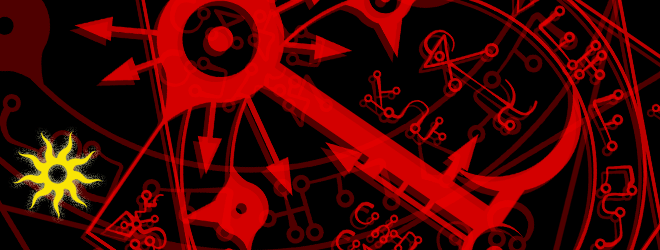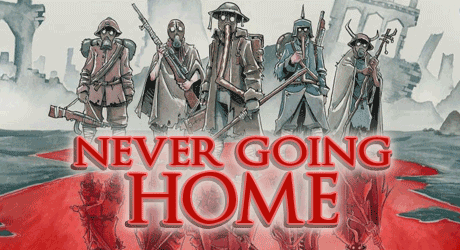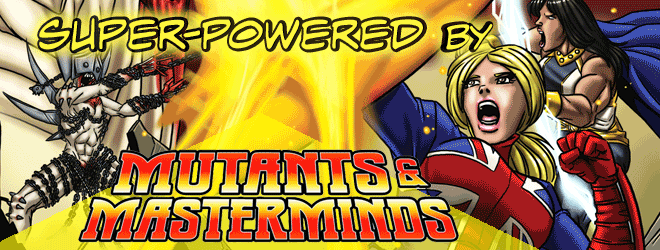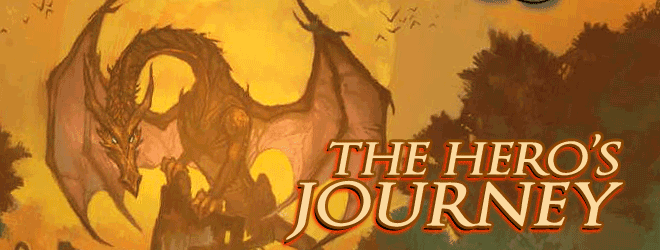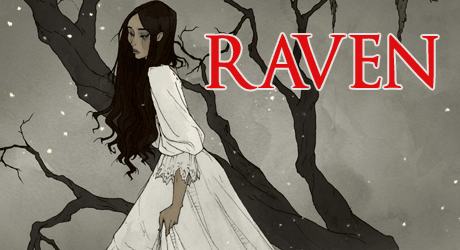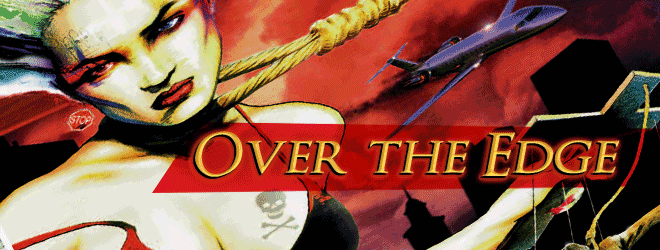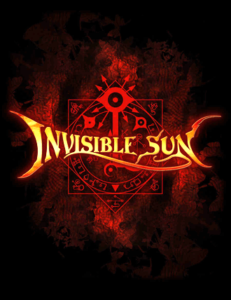 In December 2021 our customers had a new chance to heed the call of the Path of Suns with the reborn June 2020 Invisible Sun Bundle, featuring the “Digital Black Cube” that embodies the surreal, visionary Monte Cook Games RPG of vislae magicians exploring the nature of reality as they walk the Path of Suns.
In December 2021 our customers had a new chance to heed the call of the Path of Suns with the reborn June 2020 Invisible Sun Bundle, featuring the “Digital Black Cube” that embodies the surreal, visionary Monte Cook Games RPG of vislae magicians exploring the nature of reality as they walk the Path of Suns.
“Invisible Sun is not a true look at occultism or a real-world manual for magic,” says designer Monte Cook in Invisible Sun rulebook 4, The Path. More accurately, this surreal modern-fantasy RPG is an ambitious simulation of the occult philosophies of Hermeticism, Thelema, and the magician’s process of self-actualization — the “left-hand path.” And if not a practice in itself, Invisible Sun nonetheless attempted a working, a transformation — in this case, of the roleplaying market.
In August 2016 Monte Cook Games ran an Invisible Sun Kickstarter campaign to fund the “Black Cube,” a physical rules set unprecedented in the RPG field. The cubical box would be jam-packed with four hardcover rulebooks, a thousand cards, a game board and tokens, cloth maps, notebooks and pads, custom dice, character dossiers, an art book, and a resin-cast sculpture of a seven-fingered hand called the Testament of Suns. The pledge levels started at US$197 and went way up. Industry figures watched this audacious proposal with awakened interest. It seemed, after the success of many previous grand undertakings — D&D 3.x, Malhavoc Press, Ptolus, and the record-breaking Numenera Kickstarter — Monte Cook had moved beyond mundane publishing concerns. Now, it seemed, Monte intended to initiate nothing less than an overt magical ritual.
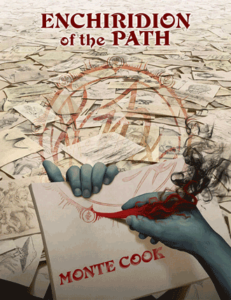 Is that a reach? Never mind what it says it’s not about — listen to what Invisible Sun is actually about: “Even as you read this, you’re doing so in Shadow. You believe it to be the real world, and the sights and sounds you see are normal. You believe the events around you have meaning and significance. But a part of you, deep down, knows they do not. There’s a part of you that knows the real world is far bigger, far more mysterious and wondrous, than the grey shades around you.” Player characters are vislae — modern-day mages, sorcerers, and other practitioners of magic. They exiled themselves to Shadow long ago to avoid a mysterious, terrible War, and have now returned to their homes in the Actuality. The world of Shadow is illuminated by a single Gray Sun, but the Actuality has eight suns. Nine, actually — though even learned people don’t know that, for the ninth is a secret. Invisible.
Is that a reach? Never mind what it says it’s not about — listen to what Invisible Sun is actually about: “Even as you read this, you’re doing so in Shadow. You believe it to be the real world, and the sights and sounds you see are normal. You believe the events around you have meaning and significance. But a part of you, deep down, knows they do not. There’s a part of you that knows the real world is far bigger, far more mysterious and wondrous, than the grey shades around you.” Player characters are vislae — modern-day mages, sorcerers, and other practitioners of magic. They exiled themselves to Shadow long ago to avoid a mysterious, terrible War, and have now returned to their homes in the Actuality. The world of Shadow is illuminated by a single Gray Sun, but the Actuality has eight suns. Nine, actually — though even learned people don’t know that, for the ninth is a secret. Invisible.
As their memories slowly return, the vislae reclaim their abandoned lives, help rebuild the surreal city of Satyrine, amass power and influence, and relearn the secrets of magic. Ambitious characters can aspire to eventually walk the Labyrinth. “Those who succeed at this lofty goal gain incredible power and access to another sphere of existence altogether, where they can walk amid the most powerful beings in the universe and test their mettle against the greatest challenge in existence.”
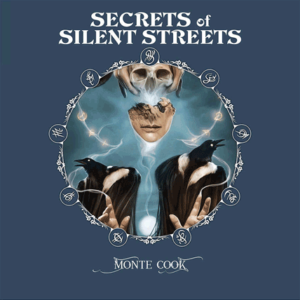 Invisible Sun characters are complex, and the creation process (described in Book 1, The Key) is a lengthy group exercise. Start by choosing your own personal roleplaying style (Builder, Explorer, Attainer, Achiever), which helps inform the Gamemaster’s worldbuilding. Your character has an Order (Makers, Weavers, Vances, Goetics, Apostates); a Heart, or magical essence (Galant, Stoic, Empath, Ardent); a Forte (such as Breathes Runes, Bears an Orb, Explores the Noosphere, and many more), which governs your magical abilities; and a soul, with a secret name and allegiance. Your appurtenance (specific style or focus) grants unique benefits, such as protection by an angel or demon, blood workings, magical firearms, or an entourage of personal assistants. You specify a character arc, such as Develop a Bond, Recover From a Wound, Justice, Restoration, Revenge, or Undo a Wrong. Progress through your arc’s story points earns Acumen, Joy, and Despair, the three currencies of advancement. You’ll eventually beseech aid from a powerful otherworldly patron, such as Frageliva Queen of Angels, the Nightmare Prince, Robysus Sovereign of Bones, or the Singular of Three.
Invisible Sun characters are complex, and the creation process (described in Book 1, The Key) is a lengthy group exercise. Start by choosing your own personal roleplaying style (Builder, Explorer, Attainer, Achiever), which helps inform the Gamemaster’s worldbuilding. Your character has an Order (Makers, Weavers, Vances, Goetics, Apostates); a Heart, or magical essence (Galant, Stoic, Empath, Ardent); a Forte (such as Breathes Runes, Bears an Orb, Explores the Noosphere, and many more), which governs your magical abilities; and a soul, with a secret name and allegiance. Your appurtenance (specific style or focus) grants unique benefits, such as protection by an angel or demon, blood workings, magical firearms, or an entourage of personal assistants. You specify a character arc, such as Develop a Bond, Recover From a Wound, Justice, Restoration, Revenge, or Undo a Wrong. Progress through your arc’s story points earns Acumen, Joy, and Despair, the three currencies of advancement. You’ll eventually beseech aid from a powerful otherworldly patron, such as Frageliva Queen of Angels, the Nightmare Prince, Robysus Sovereign of Bones, or the Singular of Three.
Gameplay at the table (described in Book 2, The Gate) proceeds in Action Mode and Narrative Mode, using a traditional roll-high success system of 1d10 rolls against a challenge rating. Spend from your Sortilege pool to gain extra dice, and from your bene to increase the results. The Gamemaster turns up Tarot-like Sooth cards that globally influence challenges, especially magic. But Invisible Sun also emphasizes Development Mode, which happens outside game sessions. On their own initiative, players develop and roleplay “side scenes” that describe their characters’ actions between sessions: a conversation, research, a shopping trip, even a flashback that fleshes out the character’s backstory. Players later describe these side scenes to the GM, who resolves uncertain outcomes with the turn of a Sooth card.
The Invisible Sun magic system is extensively, not to say extraordinarily, detailed in the 126-page Book 3, The Way. On its final page Monte Cook lists his influences, such as religions and movements (Surrealism, Dadaism, Zoroastrianism, Buddhism, Dynamism, Santeria), creators (Dali, Bowie, David Lynch, Grant Morrison, Alan Moore, Thomas Ligotti, and many more), and well-known magicians (Austin Osman Spare, A. E. Waite, Jack Parsons — maybe Grant Morrison and Alan Moore should go here), as well as Kill Six Billion Demons and Doctor Strange.
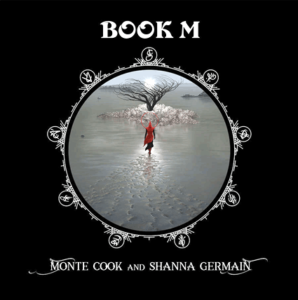 In Book 4, The Path, the path goes strongly left-handed. Much of the book is game-setting fluff — random weirdness in the Actuality a la Monte Cook Games’ Numenera and The Strange. (“Spidering can happen to anything. A book. A cat. A table. A house. Suddenly, and without warning, it sprouts eight spidery legs that match its size and begins to move around like a spider.”) We get NPCs, locations, and organizations in the campaign city of Satyrine — major supernatural entities, demons, angels, and spirits — a bestiary — and a game-mechanical description of ghosts, so vislae characters can keep playing the game even after death. So far, so conventional. Yet the opening section, “Precepts,” propounds an underlying philosophy that may not be “a real-world manual for magic,” but — well, read for yourself:
In Book 4, The Path, the path goes strongly left-handed. Much of the book is game-setting fluff — random weirdness in the Actuality a la Monte Cook Games’ Numenera and The Strange. (“Spidering can happen to anything. A book. A cat. A table. A house. Suddenly, and without warning, it sprouts eight spidery legs that match its size and begins to move around like a spider.”) We get NPCs, locations, and organizations in the campaign city of Satyrine — major supernatural entities, demons, angels, and spirits — a bestiary — and a game-mechanical description of ghosts, so vislae characters can keep playing the game even after death. So far, so conventional. Yet the opening section, “Precepts,” propounds an underlying philosophy that may not be “a real-world manual for magic,” but — well, read for yourself:
“The idea of a thing is far more important than the thing itself. […] Ideas are potent. They shape the world. Form is, at best, the emergent result of the changes wrought by essence. […] Words are magic. Words are the framework in which we, as conscious souls, describe the qualia we experience. Qualia is the real truth, and magic is the acceptance and expression of that truth. […] There’s a will behind [all things.] That can be the will of a person, a spirit, or even the creator who cast the original spell that started the world. The Actuality was born of an act of will, and thus will underlies all action.”
Yeah. Then there’s the Path of Suns, repeatedly described as a representation of the soul. “Like the colors that indicate the essence of the various realms, the Path of Suns suggests each individual is complex and ever-changing. The suns are planes of existence — distinct vibrational frequencies of one place: the Actuality. […] Each sun defines a world upon which it shines. But a sun is far more than that. Each governs aspects of reality, and entities within each realm are patrons of even more finely refined granules of that aspect. Each sun is an idea or a group of ideas. […] The Path of Suns is not only a map of the Actuality, but a map of the soul as well. The inner world as well as the outer. Which means all the suns — including the Invisible Sun — are also within us already, even if we are unaware. Our journey is one that is both spiritual and physical. In fact, when we reach this point, we begin to ask: Is there even a difference?”
So okay, you can’t use Invisible Sun to attempt spiritual transformation, but you can roleplay someone who does. Is that appealing to — anyone? An unfilled market niche? This, in August 2016, is what onlookers waited to learn. Also, of pressing interest: Who would pay two hundred bucks for an RPG? By the time the Invisible Sun Kickstarter campaign concluded, 1,846 people had, including one patron who pledged US$9,999. The final $664K gross marked another milestone on Monte Cook’s path and, for the game industry, a new, vastly expanded sense of possibility. (An October 2018 follow-up Kickstarter to reprint the Black Cube, Return to the Actuality, added a further $340K, lifting total sales over $1 million.)
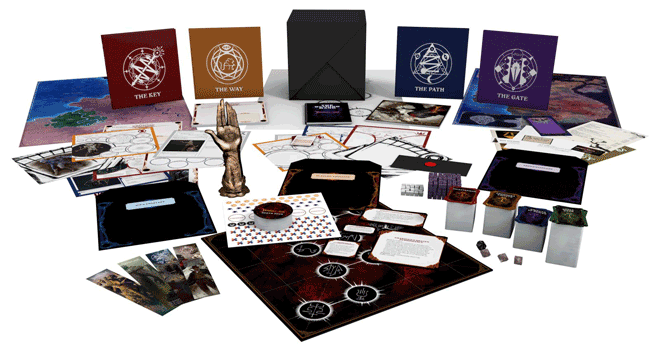
In due course MCG published the Black Cube — there’s a contents video with a rundown of the physical release’s 30 pounds (14 kilos) of impressive components — and, later, a “Digital Black Cube” (a Gold Seller on DriveThruRPG at $99) with .PDFs and image files of the Cube’s thousand pages of game material. That Digital Cube returned as the centerpiece of this reborn June 2020 Invisible Sun Bundle.
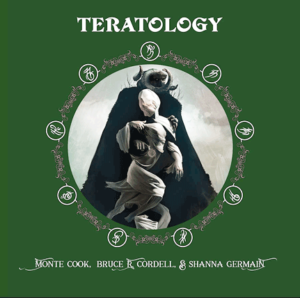 This comprehensive offer included the complete Invisible Sun Digital Black Cube (retail value $99), with a gigantic array of rulebooks, print-and-cut cards, maps, props, play aids, handouts, and muuuch more, all as DRM-free .PDF files, plus the Bonus Collection with five more supplements and play aids worth an additional $87, including Secrets of Silent Streets (the Satyrine city guide), Book M (more magic), Teratology (a bestiary), Enchiridion of the Path (secrets of the suns), and the Invisible Sun Prop-Crafting Kit.
This comprehensive offer included the complete Invisible Sun Digital Black Cube (retail value $99), with a gigantic array of rulebooks, print-and-cut cards, maps, props, play aids, handouts, and muuuch more, all as DRM-free .PDF files, plus the Bonus Collection with five more supplements and play aids worth an additional $87, including Secrets of Silent Streets (the Satyrine city guide), Book M (more magic), Teratology (a bestiary), Enchiridion of the Path (secrets of the suns), and the Invisible Sun Prop-Crafting Kit.
Ten percent of each payment (after gateway fees) went to this Invisible Sun revival’s pandemic-related charity, Direct Relief. Direct Relief sends protective gear and critical care medications to health workers, with emergency deliveries to medical facilities across the US and to regional response agencies across the world.
